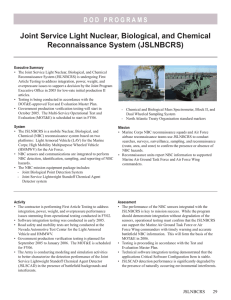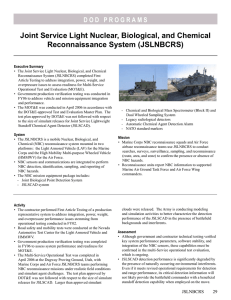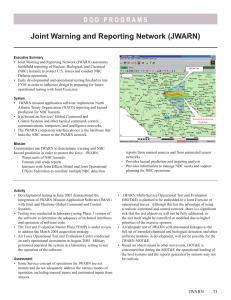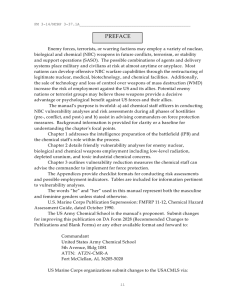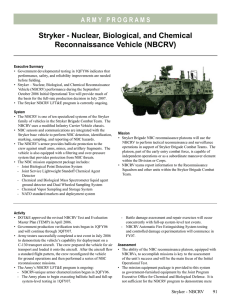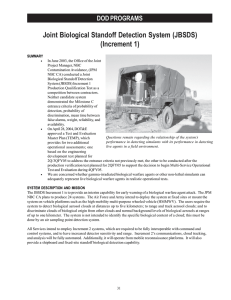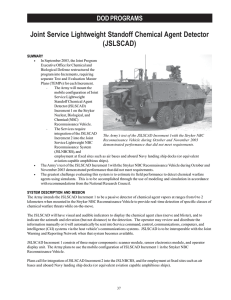T Joint Service Light Nuclear, Biological, and Chemical Reconnaissance System (JSLNBCRS) DOD PROGRAMS
advertisement
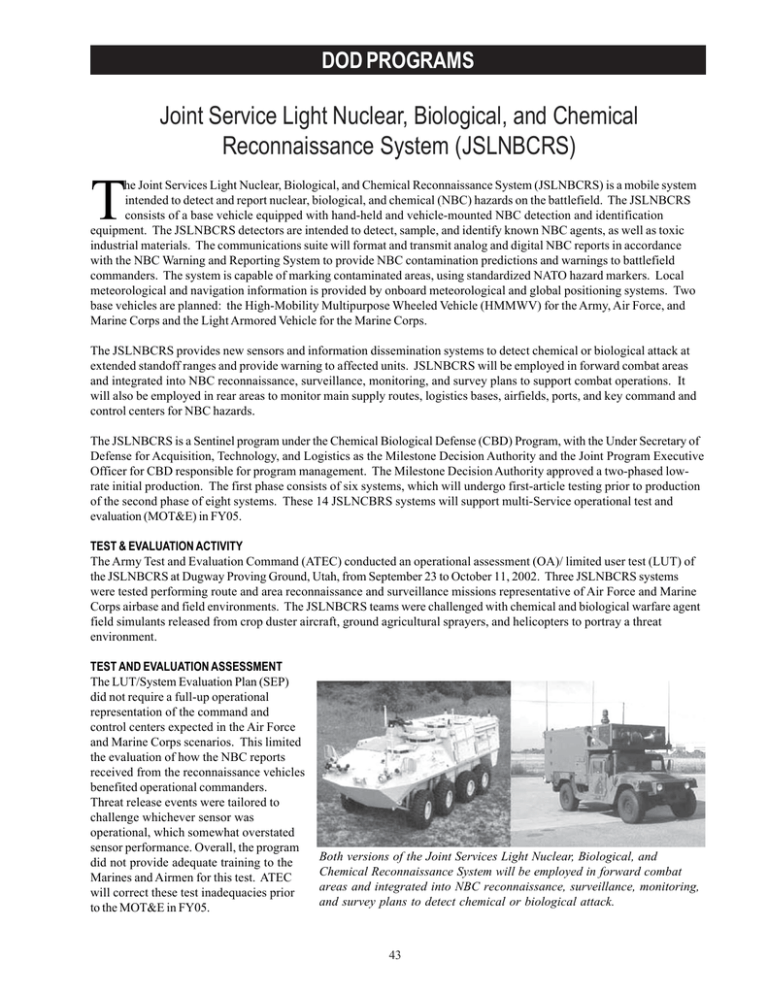
DOD PROGRAMS Joint Service Light Nuclear, Biological, and Chemical Reconnaissance System (JSLNBCRS) T he Joint Services Light Nuclear, Biological, and Chemical Reconnaissance System (JSLNBCRS) is a mobile system intended to detect and report nuclear, biological, and chemical (NBC) hazards on the battlefield. The JSLNBCRS consists of a base vehicle equipped with hand-held and vehicle-mounted NBC detection and identification equipment. The JSLNBCRS detectors are intended to detect, sample, and identify known NBC agents, as well as toxic industrial materials. The communications suite will format and transmit analog and digital NBC reports in accordance with the NBC Warning and Reporting System to provide NBC contamination predictions and warnings to battlefield commanders. The system is capable of marking contaminated areas, using standardized NATO hazard markers. Local meteorological and navigation information is provided by onboard meteorological and global positioning systems. Two base vehicles are planned: the High-Mobility Multipurpose Wheeled Vehicle (HMMWV) for the Army, Air Force, and Marine Corps and the Light Armored Vehicle for the Marine Corps. The JSLNBCRS provides new sensors and information dissemination systems to detect chemical or biological attack at extended standoff ranges and provide warning to affected units. JSLNBCRS will be employed in forward combat areas and integrated into NBC reconnaissance, surveillance, monitoring, and survey plans to support combat operations. It will also be employed in rear areas to monitor main supply routes, logistics bases, airfields, ports, and key command and control centers for NBC hazards. The JSLNBCRS is a Sentinel program under the Chemical Biological Defense (CBD) Program, with the Under Secretary of Defense for Acquisition, Technology, and Logistics as the Milestone Decision Authority and the Joint Program Executive Officer for CBD responsible for program management. The Milestone Decision Authority approved a two-phased lowrate initial production. The first phase consists of six systems, which will undergo first-article testing prior to production of the second phase of eight systems. These 14 JSLNCBRS systems will support multi-Service operational test and evaluation (MOT&E) in FY05. TEST & EVALUATION ACTIVITY The Army Test and Evaluation Command (ATEC) conducted an operational assessment (OA)/ limited user test (LUT) of the JSLNBCRS at Dugway Proving Ground, Utah, from September 23 to October 11, 2002. Three JSLNBCRS systems were tested performing route and area reconnaissance and surveillance missions representative of Air Force and Marine Corps airbase and field environments. The JSLNBCRS teams were challenged with chemical and biological warfare agent field simulants released from crop duster aircraft, ground agricultural sprayers, and helicopters to portray a threat environment. TEST AND EVALUATION ASSESSMENT The LUT/System Evaluation Plan (SEP) did not require a full-up operational representation of the command and control centers expected in the Air Force and Marine Corps scenarios. This limited the evaluation of how the NBC reports received from the reconnaissance vehicles benefited operational commanders. Threat release events were tailored to challenge whichever sensor was operational, which somewhat overstated sensor performance. Overall, the program did not provide adequate training to the Marines and Airmen for this test. ATEC will correct these test inadequacies prior to the MOT&E in FY05. Both versions of the Joint Services Light Nuclear, Biological, and Chemical Reconnaissance System will be employed in forward combat areas and integrated into NBC reconnaissance, surveillance, monitoring, and survey plans to detect chemical or biological attack. 43 DOD PROGRAMS Because the OA/LUT began without planned key system integration and interoperability tests, the JSLNBCRS systems experienced numerous integration problems with the software, sensors, and connecting cables during the test. The new development sensors integrated with the JSLNBCRS – Chemical Biological Mass Spectrometer, Joint Biological Point Detection System, and Joint Service Lightweight Standoff Chemical Agent Detector (JSLSCAD) – performed poorly mainly due to immature sensors and software. As designs mature the performance of these sensors are expected to improve. However, because the JSLSCAD has not met its operational requirements, the Joint Program Executive Officer developed an alternative strategy to fulfill the standoff chemical agent detection requirement. The Milestone Decision Authority will decide whether the JSLNBCRS will integrate the current version of the JSLSCAD or an alternative within the next fiscal year. Additional engineering and testing is required before commitment to the full number of low-rate initial production systems to support the MOT&E. Operational reliability, immature sensor integration, overpressure failures, insufficient power, excessive vehicle weight, safety, and human factors integration are key design issues that limit the system’s effectiveness and suitability in an operational environment. An OA is scheduled for late FY04, using the test results of a first-article test to provide evidence that the critical deficiencies have been corrected before the MOT&E. The Test and Evaluation Master Plan is currently being updated to reflect engineering and test plans to address these performance problems and to support an incremental approval for low-rate initial production systems for the MOT&E. The updated Test and Evaluation Master Plan must also address strategies to fulfill the standoff chemical agent detection requirement should the JSLSCAD not be available. 44
